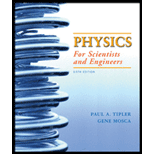
Concept explainers
(a)
The focal length of eyepiece.
(a)
Explanation of Solution
Given:
Magnifying power of microscope is
The angular magnification of eyepiece is
The distance of objective lens from eyepiece is
Formula used:
Write expression for angular magnification of eyepiece.
Here,
Calculation:
Substitute
Conclusion:
Thus, the focal length of eyepiece is
(b)
The location object so that it is in focus for normal eye.
(b)
Explanation of Solution
Given:
Magnifying power of microscope is
The angular magnification of eyepiece is
The distance of objective lens from eyepiece is
Formula used:
Write expression for angular magnification of eyepiece.
Here,
Write expression for image distance.
Write expression for magnifying power of microscope.
Rearrange above expression for
Substitute
Substitute
Rearrange above expression for
Calculation:
Substitute
Substitute
Conclusion:
Thus, the object is
(c)
The focal length of objective lens.
(c)
Explanation of Solution
Given:
Magnifying power of microscope is
The angular magnification of eyepiece is
The distance of objective lens from eyepiece is
Formula used:
Write expression for angular magnification of eyepiece.
Here,
Write expression for image distance.
Write expression for magnifying power of microscope.
Rearrange above expression for
Substitute
Substitute
Rearrange above expression for
Write expression for lens equation for objective lens.
Calculation:
Substitute
Substitute
Substitute
Conclusion:
Thus, the focal length of objective lens is
Want to see more full solutions like this?
Chapter 32 Solutions
EBK PHYSICS FOR SCIENTISTS AND ENGINEER
- 3. If the force of gravity stopped acting on the planets in our solar system, what would happen? a) They would spiral slowly towards the sun. b) They would continue in straight lines tangent to their orbits. c) They would continue to orbit the sun. d) They would fly straight away from the sun. e) They would spiral slowly away from the sun. 4. 1 The free-body diagram of a wagon being pulled along a horizontal surface is best represented by A F N B C 0 Ꭰ FN E a) A b) B c) C app app The app 10 app d) e) ס ח D E 10 apparrow_forwardPls help ASAParrow_forwardPls help asaparrow_forward
- Pls help asaparrow_forwardThe acceleration of an object sliding along a frictionless ramp is inclined at an angle 0 is 9. a) g tano b) g cose c) g sino 10. d) g e) zero A 1.5 kg cart is pulled with a force of 7.3 N at an angle of 40° above the horizontal. If a kinetic friction force of 3.2 N acts against the motion, the cart's acceleration along the horizontal surface will be a) 5.0 m/s² b) 1.6 m/s² c) 2.4 m/s² 11. d) 1.0 m/s² e) 2.7 m/s² What is the net force acting on an object with a mass of 10 kg moving at a constant velocity of 10 m/s [North]? a) 100 N [North] b) 100 N [South] 10 N [North} d) 10 N [South] e) None of these.arrow_forwardModified True/False - indicate whether the sentence or statement is true or false. If the statement is false, correct the statement to make it true. 12. An object in uniform circular motion has a constant velocity while experiencing centripetal acceleration. 13. An object travelling in uniform circular motion experiences an outward centrifugal force that tends to pull the object out of the circular path. 14. An object with less inertia can resist changes in motion more than an object with more inertia. 15. For an object sliding on a horizontal surface with a horizontal applied force, the frictional force will always increase as the applied force increases.arrow_forward
 Principles of Physics: A Calculus-Based TextPhysicsISBN:9781133104261Author:Raymond A. Serway, John W. JewettPublisher:Cengage Learning
Principles of Physics: A Calculus-Based TextPhysicsISBN:9781133104261Author:Raymond A. Serway, John W. JewettPublisher:Cengage Learning Physics for Scientists and Engineers, Technology ...PhysicsISBN:9781305116399Author:Raymond A. Serway, John W. JewettPublisher:Cengage Learning
Physics for Scientists and Engineers, Technology ...PhysicsISBN:9781305116399Author:Raymond A. Serway, John W. JewettPublisher:Cengage Learning Physics for Scientists and Engineers: Foundations...PhysicsISBN:9781133939146Author:Katz, Debora M.Publisher:Cengage Learning
Physics for Scientists and Engineers: Foundations...PhysicsISBN:9781133939146Author:Katz, Debora M.Publisher:Cengage Learning University Physics Volume 3PhysicsISBN:9781938168185Author:William Moebs, Jeff SannyPublisher:OpenStax
University Physics Volume 3PhysicsISBN:9781938168185Author:William Moebs, Jeff SannyPublisher:OpenStax College PhysicsPhysicsISBN:9781285737027Author:Raymond A. Serway, Chris VuillePublisher:Cengage Learning
College PhysicsPhysicsISBN:9781285737027Author:Raymond A. Serway, Chris VuillePublisher:Cengage Learning College PhysicsPhysicsISBN:9781305952300Author:Raymond A. Serway, Chris VuillePublisher:Cengage Learning
College PhysicsPhysicsISBN:9781305952300Author:Raymond A. Serway, Chris VuillePublisher:Cengage Learning





